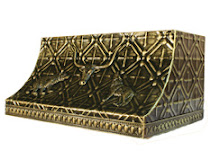 Historically, tin ceilings were introduced to North America as an affordable alternative to the exquisite plasterwork used in European homes.
Historically, tin ceilings were introduced to North America as an affordable alternative to the exquisite plasterwork used in European homes.They gained popularity in the late 1800's as Americans sought sophisticated interior design. Durable, lightweight and fireproof, tin ceilings were appealing to home and business owners alike as a functionally attractive design element that was readily available.
It was during this, the Victorian era (1839-1901), that thin rolled tin-plate was being mass-produced. Between 1890 and 1930, approximately forty-five companies in the United States marketed metal ceilings; most were in Ohio, Pennsylvania, and New York, located along railroad lines that served as the main routes for getting the pressed metal products directly to contractors.
Sheets of tin were stamped one at a time using rope drop hammers and cast iron molds. Using this method of production, metal was sandwiched between two interlocking tools. The top tool, or "ram," was lifted up by a rope or chain then dropped down onto the bottom die, smashing into the metal that was underneath. This process of repeatedly hammering the metal would permanently embed intricate patterns into the tin.
Tin ceilings were traditionally painted white, giving the appearance of hand-carved or molded plaster. They were incorporated into residential living rooms and parlors as well as commercial businesses, where painted tin was often used as wainscoting.
In the 1930's tin ceilings began to lose their popularity and ceilings, and as a result were ignored as a design element. As a result, few companies continued to produce pressed metal panels. Anyone hoping to have a tin ceiling was relegated to using salvage pieces from old buildings, an imperfect and time consuming undertaking.




1 comment:
It is very nice and interesting. thanks for sharing this.
Ceiling restoration
Post a Comment